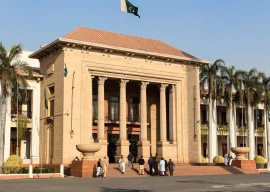
Recent months have witnessed a number of PIA aircraft making ‘emergency’ or ‘technical’ landings, while the spectre of another ban by the EU haunts the national flag carrier. The Express Tribune continues to investigate in part II of the series.
Cutting corners
Saleem Irshad*, a retired flight engineer who worked at PIA for 30 years, doesn’t concur with Pakistan International Airline’s spokesperson Mashood Tajwar, who disregards the notion that technical issues could have had perilous implications.
“There are grave problems as far as maintenance of PIA aircraft and adherence to flight procedures is concerned,” Irshad says. “For example the grease required to lubricate the plane on landing, is often substandard, and in many cases has caused the landing gear to catch fire due to friction.”
He vehemently dismisses the widely-held notion that technical irregularities in PIA’s fleet are the result of ageing aircraft.
“The ATR planes, which experienced technical failures [on September 2], were purchased three or four years ago, so it’s not a matter of an ageing fleet,” he says. “The new generation of aircraft is fuel efficient and lighter, but they need preventive maintenance, which PIA does not adequately ensure.”
A potential reason for technical deficiencies in aircraft is the plummeting standards of engineering in the airline, says the president of Society of Aircraft Engineers of Pakistan (SAEP), Shaukat Jamshed.
“For the past four or five years, we have not inducted engineers and technicians, while serving personnel have retired or migrated,” he explains. “This has resulted in a gap in engineering standards.”
He says that PIA’s A-310 planes are possibly on the verge of ban again by the EU, but dismisses the idea that safety violations by the company’s aircraft are a serious concern. “The main issue, which the French aviation authorities detected, was fuel leakage and we are currently investigating that,” he says.
Technical issues causing delays?
The dearth of standby planes is also a cause of flight delays - now a notorious trait of the airline.
“Since flights are queued back to back, even if one plane experiences some technical issue, three to four flights will get delayed in succession,” explains Jamshed.
The airline’s spokesperson, however, refutes the notion of a vicious cycle linking dearth of planes with technical predicaments and delays.
“In August and September, we were facing very bad weather and bird crowding on runways. Hence the delays,” Mashood Tajwar explains.
What about the postponement in Umrah flights during August, which highly irked pilgrims?
“It was the peak season for flights and our schedule was fully booked so delays due to unavoidable circumstances, like aircraft maintenance, resulted in long waiting hours for pilgrims,” Tajwar says.
A retired managing director for PIA marketing, however, is not apologetic. “They are all just a result of gross mismanagement,” he says. “When appointments in an organisation have been made on the basis of political and personal connections, what else would you expect?”
Who regulates the national carrier?
Why does PIA continue to be marred by mismanagement?
“Airlines everywhere will try to cut corners, but it’s the job of the regulatory authority to ensure that it meets international standards,” says Irshad. “The Civil Aviation Authority (CAA) has failed to regulate PIA, because of a stark conflict of interest. The CAA has serving and retired PIA officials and is therefore not a neutral regulatory body.”
Irshad’s point about the overlap between the two organisations - particularly in the top management - couldn’t have been truer than at present. PIA’s current Managing Director Nadeem Yousafzai previously served as Director General CAA, while retaining his position as a PIA pilot.
“How can a body effectively regulate an airline when its staff is serving at the highest positions in the former?” he asks rhetorically.
Highlighting the fact that the CAA is one of the few government organisations which generates lucrative profits, he adds, “The CAA is now primarily a revenue-generating body and its regulatory function of ensuring air worthiness of planes is secondary.”
Sources in PIA say the CAA also fails to perform its basic function of clearing runways of birds, leaving the planes vulnerable to bird hits and consequent delays.
From January to July, there were 41 incidents of bird strikes, and each hit can cause up to a million rupees in damages to the aircraft.
But CAA’s spokesperson Pervez George is quick to dismiss these allegations.
“Whoever is appointed to work for the CAA has to follow certain rules and regulations to ensure air worthiness of planes, regardless of their affiliation with PIA or any other organisation,” he asserted. “Thus the overlap between CAA and PIA does not compromise the former’s neutrality.”
Regarding the recent technical issues with PIA planes, he said, “The CAA endeavours to fully ensure the fleet’s adherence to security standards, but minor technical problems can take place any time and are beyond our control.”
With the possibility of another EU ban looming, the next few months are potentially going to be crucial for PIA and CAA’s reputation. And it will take a lot for PIA to convince travellers that their operational standards are as lofty as the skies their planes fly in.
*names have been changed
Published in The Express Tribune, October 4th, 2011.


















COMMENTS
Comments are moderated and generally will be posted if they are on-topic and not abusive.
For more information, please see our Comments FAQ